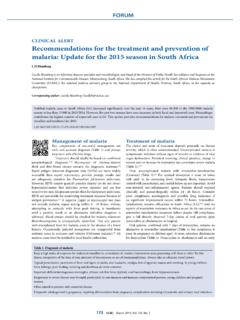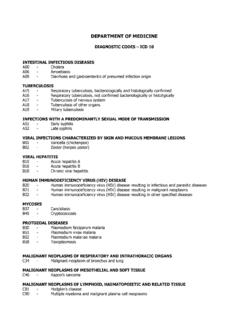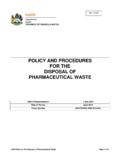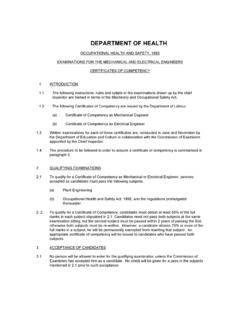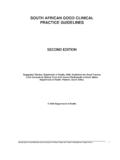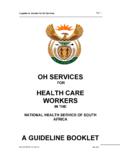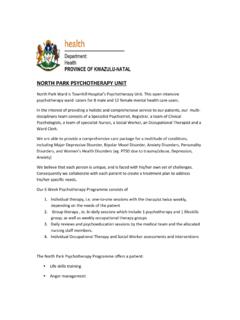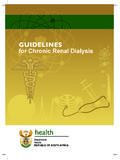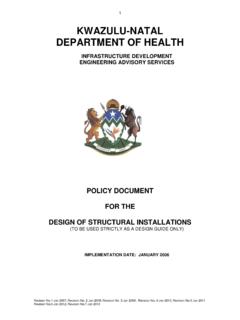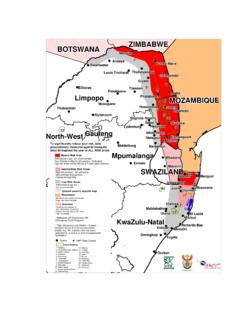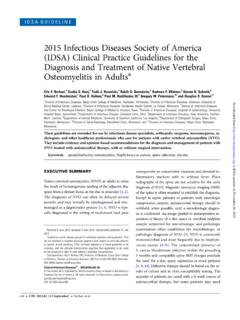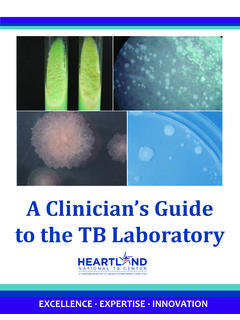Transcription of Guidelines for the prevention, diagnosis and …
1 THE SOUTHERN AFRICAN JOURNAL OF HIV MEDICINE SPRING 200725 INTRODUCTION AND BACKGROUNDW hile the developed world has seen a substantial decline inincidence rates of CC after the advent of highly activeantiretroviral treatment (HAART),1-3the enormity of theburden of AIDS on the African sub-continent and theanticipated delays in achieving full coverage of antiretroviraltherapy (ART) programmes imply that CC will continue tocause mortality among our population for years to come.
2 Theprognosis of patients with cryptococcal meningitis was verypoor prior to the availability of ART,4-6but present survivalrates in the context of ART co-administration are Consequently it has become essential toimprove the initial acute management of CC in order tomaximise the patient s chances of initial survival andsubsequent entry into the ART treatment international Guidelines for the management ofcryptococcosis10-14are written for different geographical andclinical contexts and may be impracticable forimplementation in sub-Saharan
3 Africa given limitedavailability of drugs and other AND TARGET AUDIENCE OF GUIDELINESThe objective of these Guidelines is: To set best practice standards for prevention, diagnosis ,management and treatment of HIV-associated CC. To provide practical guidance for doctors working withoutspecialist support who encounter CC in their routinepractice. To identify gaps in the evidence base to guide for the Prevention, diagnosis and Management ofCryptococcal Meningitis andDisseminated Cryptococcosis inHIV-infected patientsConvenors:Kerrigan McCarthyReproductive Health and HIV ResearchUnit, University of the WitwatersrandGraeme MeintjesDivision of infectious Diseases and HIVM edicine, University of Cape Town andG F Jooste HospitalMembers of writing committee.
4 Beth Arthington-Skaggs Mycotic Diseases Branch, Centers forDisease Control, Atlanta, USAT ihana BicanicSt George s Hospital Medical School,LondonMark CottonDepartment of Paediatrics, Stellen-bosch UniversityTom Chiller Epidemiology Unit, Mycotic DiseasesBranch, Centers for disease Control,Atlanta, USAN elesh Govender Mycology Reference Unit, NationalInstitute for Communicable DiseasesTom HarrisonDepartment of infectious Diseases, StGeorge s Hospital Medical School,LondonAlan KarstaedtDepartment of Medicine, University ofthe WitwatersrandGary MaartensDivision of Clinical Pharmacology,Department of Medicine, University ofCape TownEbrahim VaraviaDepartment of Medicine, TshepongHospital, North West ProvinceFrancois VenterReproductive Health and HIV ResearchUnit, University of the WitwatersrandHester VismerPROMEC Unit, Medical ResearchCouncil, TygerbergInternational reviewers.
5 David LallooLiverpool School of Tropical Medi-cine, UKRobert A LarsonDepartment of Medicine, Uni-versity of Southern California, USA Somnuek SungkanuparphMahidol University, Bangkok,ThailandAcknowlegements:Brian Eley and Helena Rabie for comments on management ofpaediatric note on definitions:Cryptococcal meningitis (CM) refers to meningo-encephalitisresulting from infection; disseminated cryptococcosis refers toinfection of multiple body sites; and cryptococcosis (CC) refers toinfection of any body site, with an organism from the genusCryptococcus, including Cryptococcus neoformansand C.
6 Gattii(formerly C. neoformansvar. gattii). Where the term cryptococcosis (CC) is used in this document, it refers to eithercryptococcal meningitis or disseminated supported the cost of theguideline writing committee andthe poster supplied as an insertto this issue of the 2007 THE SOUTHERN AFRICAN JOURNAL OF HIV MEDICINE26 These Guidelines do not provide guidance for the managementof CC in HIV-negative persons, or pulmonary cryptococcosis,or cryptococcosis with limited organ involvement.
7 Crypto-coccosis rarely occurs in HIV-uninfected individuals and thereare important differences in the management of thesepatients. HIV-positive patients with apparently limited organinvolvement due to C. neoformans( cutaneous crypto-coccosis) almost always have disseminated disease . STRUCTURE OF THE Guidelines Part 1 comprises Guidelines presented as a statement in atext box followed by explanatory notes. Part 2 (to be found on the HIV society website, ) presents a justification of orexplanation for the guideline, quoting available evidence.
8 PART 1: Guidelines WITH EXPLANTORY NOTESWHEN TO CONSIDER THE diagnosis OF CCSuspect cryptococcosis in all patients presenting withmeningitis: Cryptococcosis is a common cause of meningitis in theAIDS era. Patients may not be aware of their HIV status and may bein a good state of health without features of HIV or AIDSat time of presentation with CC. Clinical presentation of patients with cryptococcosis mayinclude: Symptoms and signs related to raised intracranialpressure: headache, confusion, altered level ofconsciousness, 6th cranial nerve palsies with diplopia andvisual impairment, papilloedema Fever of unknown origin Encephalitic symptoms including memory loss and new-onset psychiatric symptoms Cutaneous lesions (Fig.)
9 1) Pulmonary involvement including cavitation, infiltrationand with CM may not have neck PUNCTURE AND CT BRAINLP is essential in order to establish an aetiological diagnosis ofsuspected meningitis. LP may also alleviate symptoms such asheadache, altered level of consciousness and 6th nerve palsieswhich are a result of raised intracranial pressure. Focal neurological signs in CM are relatively uncommon;where available, CT brain should be performed first in order toexclude the presence of space-occupying lesions.
10 In resource-constrained settings where CT brain is not immediatelyavailable or likely to be significantly delayed, LP may be donewithout prior CT brain. At LP, in suspected CC: Measure opening CSF pressure (normal <20 cm CSF) (seeFig. 2). Request the following investigations routinely: microscopy(cell count, Gram stain and India ink stain), chemistry(protein, glucose), bacterial culture, fungal culture. Cryptococcal antigen (CrAg) detection should be requestedonly if the India ink test is negative.
